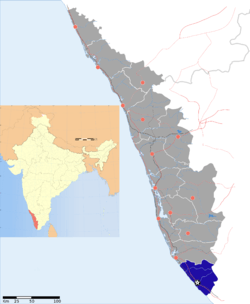Kovalam
Kovalam is an area of Trivandrum City in Kerala, India, located around 17 km south of the city center. The world famous Kovalam Beach is situated in this area of Trivandrum City.[1]
Kovalam | |
|---|---|
Suburb | |
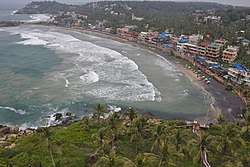 Kovalam beach, Trivandrum | |
 Kovalam  Kovalam | |
| Coordinates: 8.4004°N 76.9787°E | |
| Country | India |
| State | Kerala |
| District | Thiruvananthapuram district |
| Government | |
| • Type | Municipal Corporation |
| • Body | Corporation of Trivandrum |
| Languages | |
| • Official | Malayalam, English |
| Time zone | UTC+5:30 (IST) |

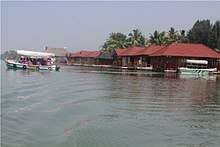
Etymology
Kovalam means a grove of coconut trees and true to its name the village offers an endless sight of coconut trees.
History
Kovalam first received attention when the Regent Maharani Sethu Lakshmi Bayi of Travancore constructed her beach resort, Halcyon Castle, here towards the end of the 1920s. Thereafter the place was brought to the public eye by her nephew the Maharaja of Travancore.[2] The European guests of the then Travancore kingdom discovered the potentiality of Kovalam beach as a tourist destination in the 1930s. However, Kovalam shot into limelight in the early seventies with arrivals of the masses of hippies on their way to Ceylon in the Hippie Trail. This exodus started the transformation of a casual fishing village of Kerala into one of the most important tourist destinations in all India.[3]
Geography
Beaches
Kovalam has three beaches separated by rocky outcroppings in its 17 km coastline, the three together form the famous crescent of the Kovalam beach.[4]
- Lighthouse Beach
- The southernmost beach, the Lighthouse Beach is the one most frequented by tourists, Lighthouse Beach got its name due to the old Vizhinjam Lighthouse located on a 35 meter high on top of the Kurumkal hillock. The lighthouse is built using stones, is colored in red and white bands and enjoys a height of 118 feet.[5] It's intermittent beams at night render the beach with an unearthly charm.[6]
- Hawah Beach
- Eve’s Beach, more commonly known as Hawa Beach, ranks second, in the early day, is a beehive of activities with fishermen setting out for sea. With a high rock promontory and a calm bay of blue waters, this beach paradise creates a unique aquarelle on moonlit nights.
- Samudra Beach
- A large promontory separates this part from the southern side. Samudra Beach doesn't have tourists thronging there or hectic business. The local fishermen ply their trade on this part.
Detour past Kovalam junction to land on Samudra Beach which is to the north of Ashoka Beach. One has the option to walk along the sea-wall too. The sight of the waves lashing on the rocks below is awesome.
Shallow waters stretching for hundreds of metres are ideal for swimming. The beaches have steep palm covered headlands and are lined with shops that offer all kinds of goods and services.[7]
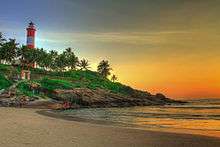
The larger of the beaches is called Lighthouse Beach for its 35 meters high lighthouse which towers over it atop Kurumkal hillock. The second largest one is Hawah Beach named thus for the topless European women who used to throng there. It was the first topless beach in India. However topless bathing is banned now except in private coves owned by resorts. Visitors frequent these two beaches. The northern part of the beach is known as Samudra Beach in tourism parlance. A large promontory separates this part from the southern side. Samudra Beach doesn't have tourists thronging there or hectic business. The local fishermen ply their trade on this part. The sands on the beaches in Kovalam are partially black in colour due to the presence of ilmenite and Monazite. The normal tourist season is from September to May. Ashoka beach is also part of Kovalam beach.
Places to visit
- Karamana River - Karamana River originates from the southern part of Sahyadri Range. The river predominantly flows through an outskirt region of Kovalam called Karmana, hence the nomenclature.
- Vellayani Lake
- Halcyon Castle
- Kovalam Art Gallery
- Valiyathura Pier
- Neyyar Dam
- Aruvikkara Dam
- Thiruvallam Parasurama Temple
- Vizhinjam Rock Cut Cave Temple
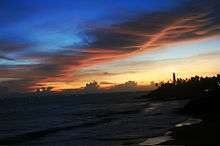
Tourist facilities
There are a large number of beach resorts in and around Kovalam. The sea port of Vizhinjam is about 3 km away and famous for its special varieties of fish, old Hindu temples, big churches and a mosque. The Proposed International Trans shipment Terminal at Vizhinjam is also close to Kovalam.
Kovalam was among the most prominent tourist spots in India during the hippy era. It still has a high status among tourists, who arrive mostly from Europe and Israel. Kovalam is finding a new significance in the light of several Ayurvedic salons, and recuperation and regeneration resorts which provide a wide variety of Ayurvedic treatments for tourists.[8]
Transport
The nearest train station is Thiruvananthapuram Central railway station, about 16 km (9.94 mi) away. The nearest airport is Trivandrum International Airport, about 10 km (6.21 mi) away.
Politics
Kovalam assembly constituency is part of Trivandrum (Lok Sabha constituency).[9] In 2016 Kerala Assembly elections, M Vincent of the Indian National Congress defeated incumbent Jameela Prakasham by over 2,500 votes.[10]
Gallery
 Kovalam Light House
Kovalam Light House- Kovalam Light House beach
- Lighthouse beach
- Hawwah beach (Eves beach)
- Samudra beach
 Kovalam beach - view from lighthouse
Kovalam beach - view from lighthouse- Kovalam Beach - View from lighthouse (other side)
- Kovalam beach with Leela Kovalam in the background
 Fishermen and bystanders bringing a fishing boat ashore on Kovalam (Lighthouse) beach (May 2002)
Fishermen and bystanders bringing a fishing boat ashore on Kovalam (Lighthouse) beach (May 2002)
References
- "Kovalam". KTDC. Archived from the original on 21 September 2012. Retrieved 31 August 2018.
- "Paradise of South India - Kovalam". kovalam.com. Archived from the original on 11 October 2007. Retrieved 7 January 2008.
- "Kovalam". kovalam.hotels.com. Retrieved 7 January 2008.
- "Kovalam video". travel trends360.wordpress.com. Retrieved 7 January 2016.
- Kovalam Travel Guide Archived 2015-02-22 at the Wayback Machine
- "kovalam.org". kovalam.org. Archived from the original on 4 January 2014. Retrieved 6 November 2013.
- Ayub, Akber (ed), Kerala: Maps & More, 2006 edition 2007 reprint, p. 97, Stark World Publishing, Bangalore, ISBN 81-902505-2-3
- Ayurveda Archived 15 April 2015 at the Wayback Machine Ayurveda in Kovalam
- Assembly Constituencies - Corresponding Districts and Parliamentary Constituencies (PDF) (Report). Election Commission of India. Archived from the original (PDF) on 4 March 2009. Retrieved 5 August 2016.
- "Election trends". Retrieved 5 August 2016.
External links

| Wikimedia Commons has media related to Kovalam. |

- Kovalam Tourism

